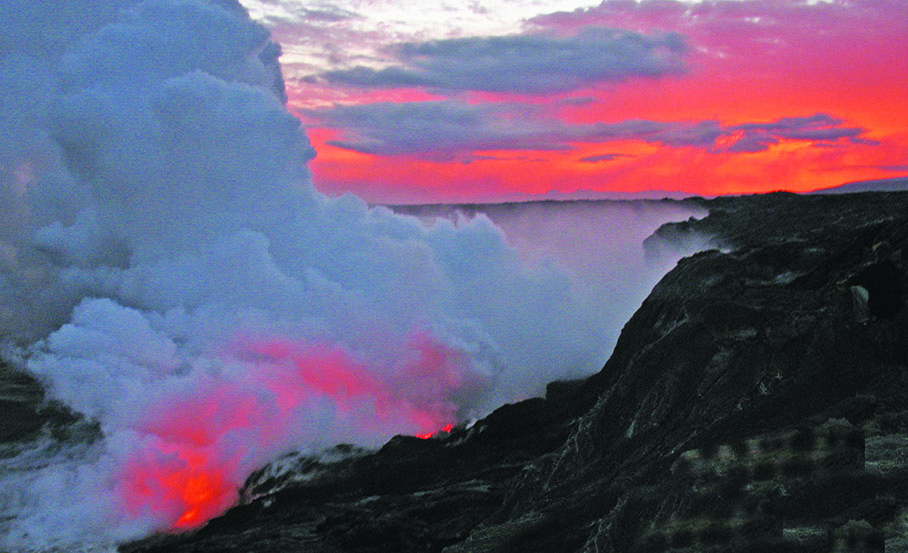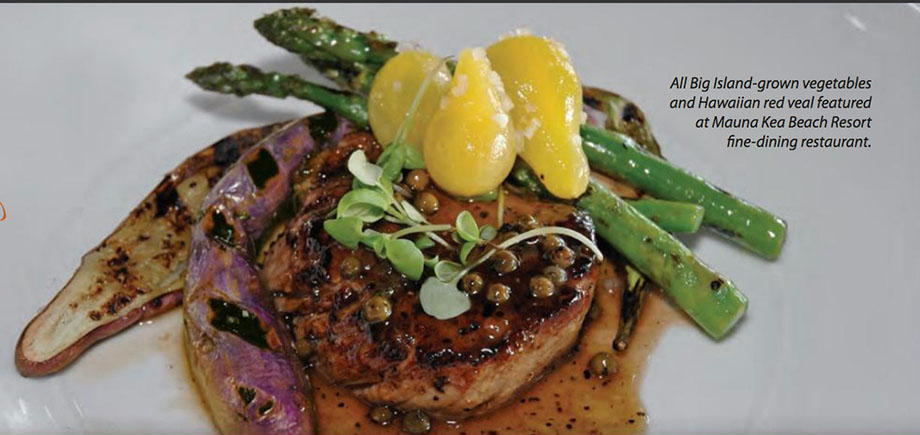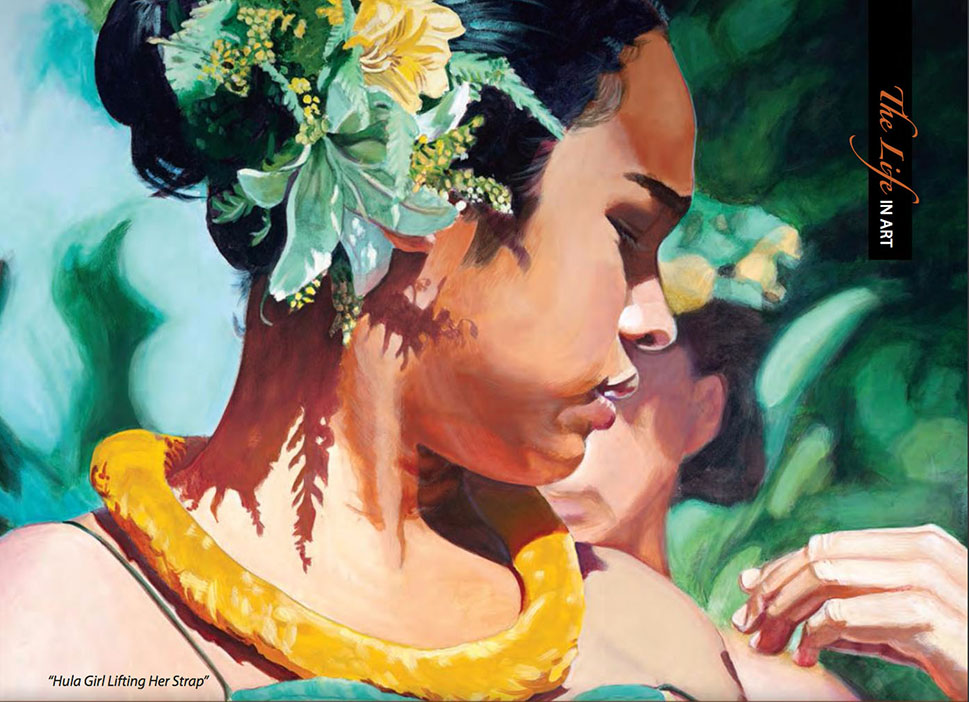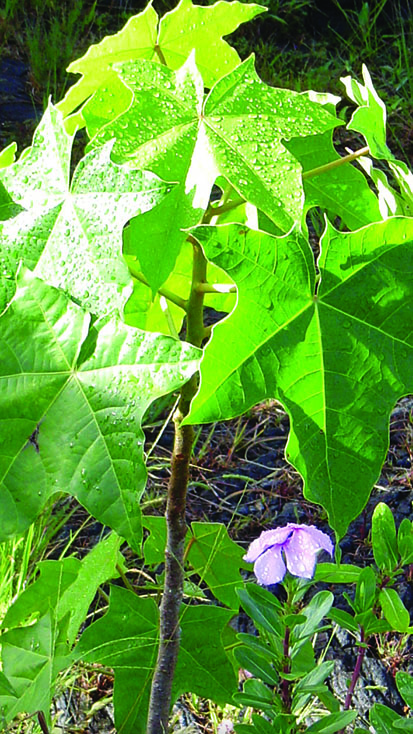
Home on an Active Volcano: Visions from the 1984 Eruption of Mauna Loa

By Wayne Stier
Island. The concept I understand with ease; it’s the reality of it that I have had to adjust to. I grew up as far from oceans and islands as a person can in America—in the center of the Great Plains.
When I moved pen, paper, and word processor to Hawaii, I rented a remodeled coffee shack in Kona on the lower western slope of Mauna Loa—a still-active volcano.
Instead of the familiar flatness in every direction, the land here tilts to become a diagonal plane between the horizontal worlds of ocean and afternoon clouds. The summit above me is 13,679 feet farther from the earth’s core than the curling waves at the shore. If lava from the top ever chose the shortest route to the sea, it would head west for 20 miles and flow right over my coffee shack. In 1950 it took lava only four-and-a-half hours from fissure to sea; and that route, just south of here was not as steep as it is where I live. I like to keep my car in good repair.
Usually I’m not very geologically aware of where I live; this changed in 1984, when Mauna Loa blew. After a nine-year sleep, a wink in geological time, the large volcano began pouring blood-red liquid rock from a fissure near the summit.
I had visions of Pompeii, of people petrified for eternity in a hot immovable hell. Which way is it flowing? The flow was going east, I discovered with relief. Nonetheless, from that moment on I have been conscious of the reservoir of molten magma beneath my feet and perhaps above my head. The high horizon disappeared. Smoke haunted the west side of the Big Island, ghosts of the ohia forest burning on the eastern slopes. The lava crept toward Hilo.
In Kona, I gave up hope of ever seeing anything brighter than an amber sun at midday. The death of the ohia trees cast a shadow that darkened distant Guam and beyond. And the lava crept eastward.
We watched nuclear-orange sunsets. Many of us sneezed in the vog. Meanwhile, day after day the volcano oozed an Amazon of blood-rock.
I began to do some research about this island home of mine. Mauna Loa is the largest active volcano on the planet. As I read of this, an earthquake shook my coffee shack. The Giant fidgets.

I had learned that Hawaiian volcanoes were tame; there are roads where tourists can drive up to the observatory even during an eruption. Instead of like Vesuvius gushing lava and dangerous gases that destroys life, Mauna Loa threatened like an attacking army mounting a siege. The flow had pooled, or rather laked in the saddle between Mauna Loa and Mauna Kea. The temperature of the lava at the spewing summit was getting hotter. That meant the magma was coming up from a deeper source inside the earth, from as deep as 2,000 kilometers!
For Hilo the danger was imminent. When lava slows, it forms tubes beneath its surface skin of new-formed rock. Hot lava can shoot through these tubes like water through a sluice. It gushes unobstructed by forest and uncooled by rain. A tube from a previous flow opened its mouth very near the lava lake. This tube extends all the way under Hilo. It the lava lake were to expand and reach that opening, it would race downhill unimpeded and grill Hilo.
Nothing like that happened. Mauna Loa stopped flowing.
It was as if I had been leaning into a gust of wind that suddenly quit. I stumbled into another of the island’s realities, a peaceful Eden of greenery. The dull grey horizonless sunsets were washed away by the afternoon rains, and clean hues of gold and blue appeared once more in the sky and ocean.
An old friend,Tau, a frequent visitor to my coffee shack, arrived late one night and roused me out of bed to tell me, “Kilauea, she’s blowin’! Fifteen hundred feet high!” This time the vent was near the road.
The tires of my car screeched around the curves on the windy two-hour ride to fire mountain. The orange road-reflectors drew a dotted line into a sky full of boasting stars. To my left was a tinge of pink edging the otherwise invisible clouds, invisible but for the lack of stars in that portion of the sky.
The road dove toward the sea. Across the water of the indented coastline, a spear of orange light stabbed a flesh-colored cloud. The torch grew larger as we sped toward it. That cloud took the form of a grotesque face, a Corinthian column, a naked woman in an evocative stretch….
 As we parked the car beside several others, we heard the roar of a blast furnace in the wilderness.
As we parked the car beside several others, we heard the roar of a blast furnace in the wilderness.
Our flashlights found the charcoal-colored path in the blackness of night and lava. With only a few wrong turns we breezed over two miles of cold lava to the viewing station at the peak of a dormant vent called Pu’u Huluhulu. Flames five miles away painted the faces of fifteen fellow fire gazers with a ghostly salmon hue. A couple, wrapped in a blanket, celebrated with wine glasses in their hands. Others were stooped behind their tripod-steadied cameras. Tau and I shared a pair of binoculars, and neither of us gave them up on the first request from the other.
From the moment I reached the crest of the viewing cone, my eyes were riveted onto the distant jet of fire. Occasionally, a slow-motion arm of flame would swing into space like a close-up movie of a sun flare, like a tai chi master dancing and then float downward to fountain the side of the new mountain with red.
I wasn’t satisfied; I wanted to be closer. I had heard there was a path said to be treacherous even in the daytime. It was irrational, dangerous, possibly fatal to attempt the journey on a moonless night with dimming flashlights. Tau, of course, agreed to go without hesitation.
For a while we trekked by the light of the volcano. But sight helped little over solid rivers of rock, tongues of pahoehoe, over petrified motion, motionless oceans of rock, over crunchy a’a with cutting glass edges. The world was a three-dimensional puzzle.
Several times we lost the path. Once I mentioned to Tau, “You know, this is symbolic of our journey through life. We are lost in a maze, picking our way in the darkness toward the light.” Markers—three to five-foot high piles of lava rock—became our sculpted lifeline. The world was a whirl of black rock in the darkness. When our progress put a hill between us and the volcano, we judged our direction by these markers and the stars.
The path led us through sulfurous steam that cut off all vision for minutes at a time. We felt our way. The earth at our fingers was warm. I imagined I walked on the surface of a bubble above a pool of liquid fire.
There is no better definition for lost than being on a lava field at night when the flashlight fails. We couldn’t find the next marker though we looked for an hour. When the volcano sent up a huge blast, we discovered from the burst of light that we were perched on the edge of a pit with no apparent bottom. I threw a rock in but heard nothing. We decided to sleep on the hard, slanted but smooth tongue of rock for the two hours remaining until dawn. We huddled from the wind behind a small ridge near the last marker we had found.
In the morning we discovered we had been only three markers away from a fern forest where the path became evident once more. We trekked through this dwarfed fern forest and over a five-year old flow to the crest of a hill where the volcano once more came into view.
We descended into a caldera, once a lava lake. We passed human-like figures in flowing robes, lava trees made by the cooling of lava missiles around a tree that subsequently burned to leave only hollow sculptures.
The hike back to the car was a long seven miles. I was both exhausted and exhilarated by the experience. I had seen had felt the heat of a furnace blasting from a cone-shaped mountain. Raw energy! But strangely, I felt somehow cheated. It wasn’t until later that I grasped the magnitude of my experience.
On the way home my car overheated. I pulled over and lifted the hood. When I twisted the radiator cap, the burst of steam and rusty scalding water woke me from my half-sleep. It occurred to me that this blast of steam was insignificant compared to the huge explosion I had witnessed from Kilauea. And Kilauea is a baby growing out of the waist of mighty Mauna Loa. I am beginning to get a feel for where I live. ❖
“Home on an Active Volcano” is excerpted from Hawaii Blue, Tales from a Place Called Paradise, by Wayne Stier. It is available from Kona Stories Bookstore at Mango Court in Kainaliu.
Big Island author, playwright, teacher and friend Wayne Stier walked his last adventure on May 30 of this year, when he passed away. He will be missed by us all.


